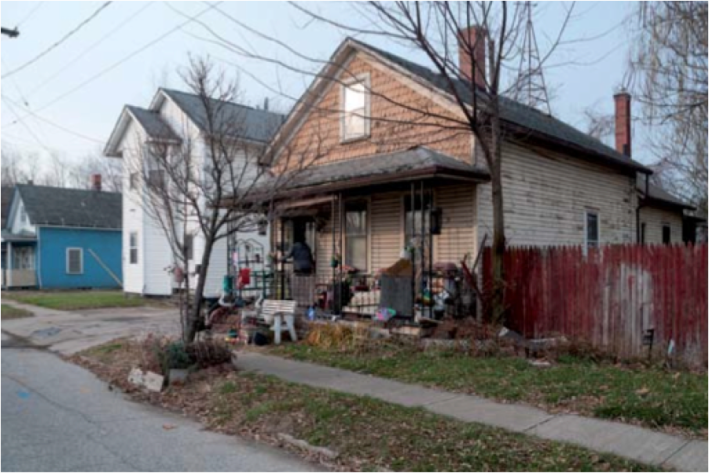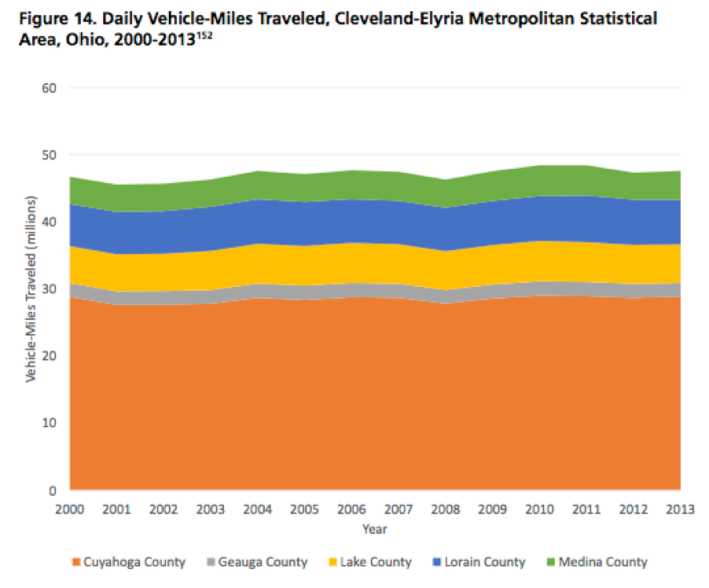
A recent report by U.S. PIRG and the Frontier Group, “Highway Boondoggles: Wasted Money and America’s Transportation Future,” examines 11 of the most wasteful, least justifiable road projects underway in America right now. Here’s the latest installment in our series profiling the various bad decisions that funnel so much money to infrastructure that does no good.
The Ohio Department of Transportation (ODOT) is promoting a $331 million, three-mile, five-lane road construction project starting at I-490’s terminus south of the city’s downtown and running northeast to the University Circle neighborhood. But it’s hard to see what need it would be meeting.
The number of miles driven in and around Cleveland has been stagnant for more than a decade. And though project proponents have tried to package the project as an “opportunity corridor” that would help the disadvantaged neighborhoods the road would traverse, the communities that would supposedly benefit have other priorities. Part of the neighborhood would also have to be destroyed to make room for the road.
Expanding road capacity is a questionable investment given recent travel trends in the Cleveland area. While ridership on the regional transit authority has been increasing, vehicle-miles traveled (VMT) in Cuyahoga County rose an anemic 0.3 percent from 2000 to 2013, an annual average of 0.02 percent. In the five counties making up the Cleveland-Elyria Metropolitan Statistical Area, VMT climbed just 1.9 percent from 2000 to 2013, an annual average increase of 0.14 percent.

Critics of the project point out that the $100 million per mile set aside for constructing the new road could instead provide more than enough money to fix all the roads in Cleveland that need repaving and repair. (ODOT has declared a “fix-it-first” policy that is supposed to prioritize repair of existing roads over construction of new highways, but the agency lacks policies to ensure the principle is actually followed.) The $331 million price tag is also larger than the annual budget of the city’s public transit system. That system already does not adequately serve the existing neighborhoods, and in fact is slated to serve them worse with the expected closing of a key rail rapid-transit stop.
The positive economic effects that project backers claim will flow to the neighborhoods traversed by the Opportunity Corridor are vague at best. And local developers are skeptical that any benefit of the road would arrive without significant additional public investment. The project design documents acknowledge that some impacts on the local neighborhood will be “disproportionately high and adverse,” including relocating 76 households and 16 businesses, as well as a church, and turning nine roads that currently connect with other streets into dead ends.
In an effort to mitigate those impacts and provide options for local residents without cars, ODOT proposes to build two pedestrian/bicycle bridges over the new road, improve bus shelters along the new road, and “create a new entrance to the St. Hyacinth neighborhood by constructing enhancements . . . [that] will include street trees and sidewalk and pavement repairs or improvements.” Community residents, however, say most of that work wouldn’t be needed if not for the new road itself, and in any case it’s not enough to boost local economic development measurably. And those are just the community members who have gotten involved in a process that has taken significant criticism for leaving out the voices of local residents.
A highway construction project makes little sense as an economic development tool for the neighborhood, where as many as 40 percent of residents do not drive at all. It also goes against the expressed desires of residents around the region, who are calling for increased investments in public transportation and in the development of communities that are less dependent on cars.
A 2012 survey by the Natural Resources Defense Council found that “a combined 68 percent of Cuyahoga County respondents say improving public transportation (35 percent) and developing communities where people don’t have to drive as much (33 percent) are the best ‘long term solutions to reducing traffic’ in their area — rather than other options like building roads (21 percent).”
Phineas Baxandall, senior policy analyst at U.S. PIRG, and Jeff Inglis, policy analyst at the Frontier Group, are co-authors of the report, “Highway Boondoggles: Wasted Money and America’s Transportation Future.”





